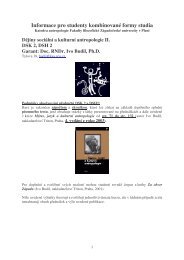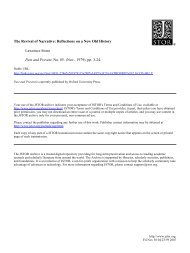BOB SCRIBNER Historical Anthropology of Early Modern Europe
BOB SCRIBNER Historical Anthropology of Early Modern Europe
BOB SCRIBNER Historical Anthropology of Early Modern Europe
You also want an ePaper? Increase the reach of your titles
YUMPU automatically turns print PDFs into web optimized ePapers that Google loves.
Bob ScribnerThe historical application <strong>of</strong> anthropological models has not been withoutcontroversy. Two pioneering studies, by Alan Macfarlane and KeithThomas on witchcraft, were accused at an early stage <strong>of</strong> too glibly takingover the assumptions <strong>of</strong> functionalist anthropology, so that witchcraftaccusations were seen just to fulfil the function <strong>of</strong> reducing social strain.Even if their analyses were pitched at the micro- rather than the macrosociologicallevel (the village rather than state or 'society'), both stronglyemphasised the social usefulness <strong>of</strong> witchcraft accusations. Thomas inparticular was accused <strong>of</strong> being over-influenced by Malinowski's psychologicalapproach, explaining witchcraft accusations in terms <strong>of</strong> their rolein overcoming anxiety and guilt. Although Thomas defended himselfagainst this charge, there is no doubt about the psychological orientation<strong>of</strong> much <strong>of</strong> his explanation <strong>of</strong> witchcraft, while psychology certainlyplayed a central role in Macfarlane's study <strong>of</strong> Essex, where witchcraftaccusations were explained in terms <strong>of</strong> a transfer <strong>of</strong> guilt felt by anaccuser for charity refused to the accused. Meanwhile many anthropologistshad come to regard psychology as <strong>of</strong> dubious value for explainingphenomena such as witch belief, and the emphasis that began to gainground was one orientated to reconstructing the meaning <strong>of</strong> witch beliefsfor those who held them 2 .Thomas' mode <strong>of</strong> analysis was actually remarkably eclectic and manysidedand was not wholly incompatible with a meaning-orientated approach.Indeed, he emphasised, albeit late in the book, that the problemwas 'to <strong>of</strong>fer a psychological explanation <strong>of</strong> the motives <strong>of</strong> the participantsin the drama <strong>of</strong> witchcraft accusation, a sociological analysis <strong>of</strong> the situationin which such accusations tended to occur, and an intellectual explanation<strong>of</strong> the concepts which made such accusation plausible' 3 . Nonethe-2 A. Macfarlane, Witchcraft in Tudor and Stuart England (London, 1970); Keith Thomas, Religion and the Decline <strong>of</strong> Magic (Harmondsworth, 1973). Criticism <strong>of</strong> Thomas by Hildred Geertz and Thomas' reply in 'An <strong>Anthropology</strong> <strong>of</strong> Religion andMagic', Journal <strong>of</strong> Interdisciplinary History 6 (1975), 71 - 109. For the multiplicity<strong>of</strong> approaches to witchcraft, see the early collection <strong>of</strong> comparative essays inM. Marwick, ed., Witchcraft and Sorcery (Harmondsworth, 1970).3 Religion and the Decline <strong>of</strong> Magic, p. 559. For a nuanced and highly perceptivereading <strong>of</strong> Thomas' work and its critics, see Jonathan Barry, 'Keith Thomas and theProblem <strong>of</strong> Witchcraft. Explanations and Representations <strong>of</strong> Witchcraft since Religionand the Decline <strong>of</strong> Magic', in Witchcraft in <strong>Early</strong> <strong>Modern</strong> <strong>Europe</strong>. Studies in Cultureand Belief, ed. Jonathan Barry, Marianne Hester, Gareth Roberts (Cambridge University Press, forthcoming).







